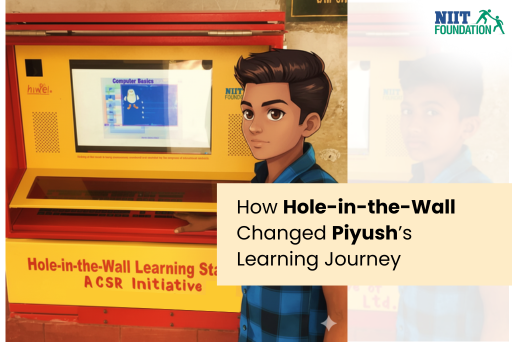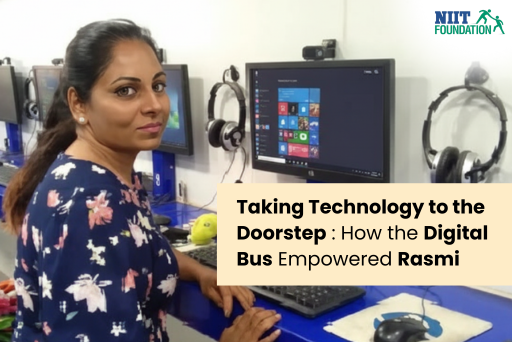At Prathmik Shala Juna Borbhatha, a quiet seventh grader named Piyush Naresh Bhai Patwadiya once struggled to keep up with his classmates. His father, an auto driver, and mother, who sells vegetables at the local market, always encouraged him, but conventional teaching methods left him behind.
Piyush was a slow learner, often restless in class. He found Maths, Science, and English especially difficult. Sitting at the back of the classroom, he rarely participated. Over time, he began losing interest in studies and even in attending school.
That began to change in February 2018, when Hole-in-the-Wall Learning Station (HiWEL) was introduced in his school.
A Window of Possibility
The Learning Station caught Piyush’s curiosity almost instantly. Unlike textbooks and lectures, it allowed him to learn at his own pace, through examples and play-way methods. Slowly but surely, he started revisiting concepts he once struggled with.
He discovered joy in solving Maths problems using interactive tools and developed a fondness for using MS Paint. The once reserved boy began encouraging his classmates to use the station too. His teacher, Ms. Hemlata Ben, observed a visible shift: greater concentration, active participation in class, and above all—a renewed eagerness to come to school every day.
Piyush’s journey is a testament to how access to innovative learning can turn hesitation into confidence.
The Idea Behind Hole-in-the-Wall
The concept of Hole-in-the-Wall Learning Station was pioneered by Dr. Sugata Mitra, NIIT’s Chief Scientist Emeritus. The first experiment in New Delhi placed a computer kiosk in a literal “hole in the wall” that separated NIIT’s office from the adjoining Kalkaji slum. Left unsupervised, children from the slum explored the machine, teaching themselves how to use it.
The results were groundbreaking: children, regardless of their socio-economic background, could learn on their own when provided access to technology. This simple yet powerful idea has since grown into a global model of minimal invasive education—bringing learning opportunities to millions of children.
Today, over 200 active Hole-in-the-Wall Learning Stations exist in India and abroad, having touched the lives of more than 2.5 million children.
Why It Works
The Hole-in-the-Wall methodology removes barriers to technology and creates a self-learning environment. Stations are placed in slums, playgrounds, community buildings, or school corridors—locations where learning feels natural and accessible.
Key benefits include:
- Learning anywhere: Brings education to remote and underserved communities.
- Access to technology: Quality digital tools and content for learners of all ages.
- Solar-powered kiosks: Ensuring uninterrupted access, even in areas with poor electricity.
- Gender equality: Open to every child, with no distinction made between boys and girls.
- Reduced dropouts: Improves attendance and reduces out-of-school children.
- Collaborative learning: Encourages group exploration and peer-to-peer teaching.
- 21st-century skills: Builds digital literacy, problem-solving, and life skills.
Beyond Academics
National-level research on Hole-in-the-Wall has shown that it doesn’t just lead to computer literacy. It also improves learning outcomes across subjects, strengthens life skills, and even has a positive social impact within communities.
Children like Piyush show us what is possible when curiosity meets opportunity. From once being reserved and restless, he is now an eager learner, confident with technology, and an inspiration for his peers.
For children across India’s urban slums and rural villages, Hole-in-the-Wall Learning Stations are more than just computers in kiosks—they are windows to the world.















